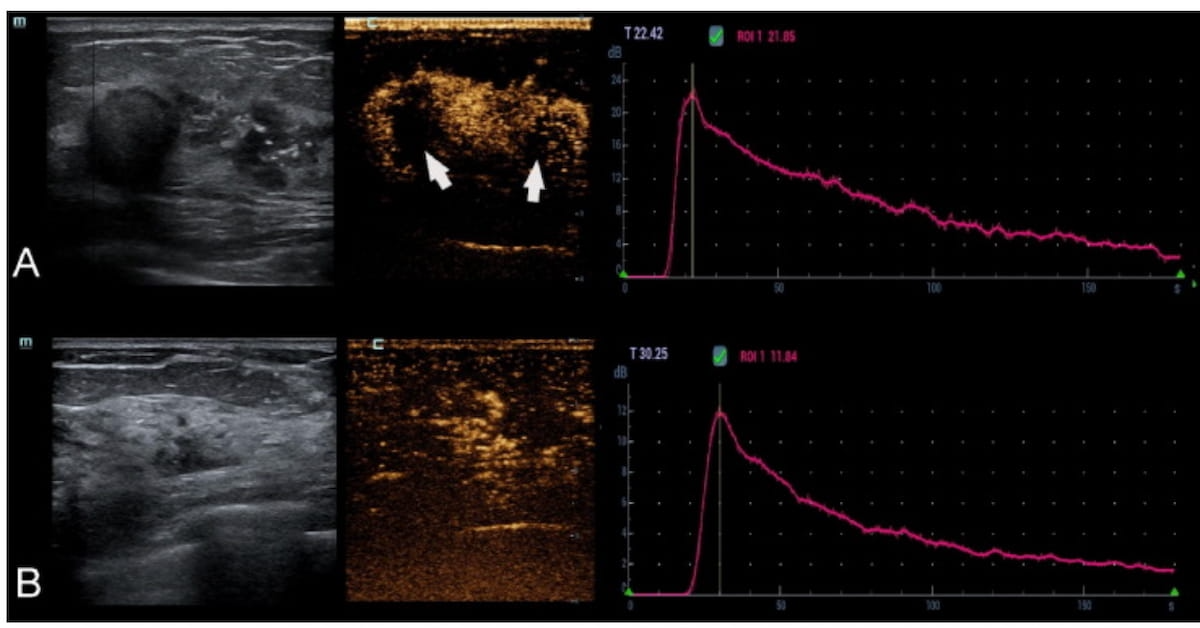Contrast-enhanced ultrasound (CEUS) may significantly improve preoperative assessment of ductal carcinoma in situ (DCIS) for potential progression to invasive breast cancer.
In a new retrospective study, recently published in the European Journal of Radiology, researchers reviewed mammography (MMG), conventional ultrasound (CU), CEUS and clinicopathologic data from 138 patients (average age of 51.5) with a total of 140 DCIS lesions. Postoperative pathology results led to upgrading of 59 DCIS lesions (42.1 percent) to invasive breast cancer, according to the study authors.
In addition to CU findings of a mass-like lesion and lesion size > 20 mm, suspicious calcification on MMG and high-grade DCIS at biopsy, the researchers noted that CEUS detection of perfusion deficit and an area under the time intensity curve (TIC) > 1021.34 ml were factors that were independently associated with the progression of DCIS to invasive breast cancer.
The study authors also found that a predictive model including MMG, CU and clinicopathologic findings had a 75.9 percent area under the receiver operating curve (AUROC) for predicting DCIS upgrade. However, the researchers noted the addition of the two CEUS predictive factors to the model led to a greater than 10 percent increase in the AUROC (86.1 percent).
“ … These data suggest that the combination of the proper imaging modalities could help to efficiently select biopsy-proven DCIS lesions that are at a higher risk of pathological upgrade,” wrote lead study author Ying Zhu, M.D., who is affiliated with the Department of Ultrasound at Shanghai Ruijin Hospital and the Medical School of Shanghai Jiao Tong University in Shanghai, China, and colleagues.
The researchers noted that 59.3 percent of cases involving upgraded DCIS lesions involved CEUS-detected perfusion deficits in contrast to 28.4 percent of cases with no pathology upgrade of DCIS lesions.
“On CEUS examination, the occurrence of perfusion defects often represents the presence of intratumoral hamorrhagic and necrotic foci. … This finding could be explained by the process of invasive tumour growth, where aggressively invasive carcinomas rapidly outgrow their blood supply, leading to areas of hypoxia and subsequent necrosis,” noted Zhu and colleagues.
Three Key Takeaways
1. Enhanced diagnostic accuracy with CEUS. The study found that the use of contrast-enhanced ultrasound (CEUS) significantly improves the accuracy of preoperative assessments for ductal carcinoma in situ (DCIS) by identifying cases at higher risk for progression to invasive breast cancer.
2. Key CEUS predictive factors for DCIS progression. The presence of a perfusion deficit on CEUS and an area under the time intensity curve (TIC) greater than 1021.34 ml were identified as independent factors associated with the progression of DCIS to invasive cancer.
3. Improved predictive model performance. Adding CEUS findings to another predictive model (which included mammography, conventional ultrasound, and clinicopathologic data) increased the area under the receiver operating curve (AUROC) by more than 10 percent, enhancing the ability to predict which DCIS lesions are likely to upgrade to invasive disease.
Patients with upgraded DCIS lesions also had a significantly higher area under the TIC (1172.17 ml) in comparison to those with no upgrading of DCIS lesions (952.69 ml), according to the study authors.
“The area under TIC, defined as the integral of the area under the enhancement curve after the injection of contrast agent, can assess the relative total blood volume of the selected lesion’s area. Angiogenesis in breast cancer increases with the onset of invasion. It can be expected that the perfusion level becomes more advanced as the lesion progresses from in situ to invasive, which is reflected in the numeric values in our study,” explained Zhu and colleagues.
(Editor’s note: For related content, see “Mammography Study Shows Supplemental Ultrasound Has Higher Sensitivity than Adjunctive AI in Dense Breasts,” “What a New Mammography Study Reveals About Surveillance Imaging in Women Treated for Ductal Carcinoma In Situ” and “Image IQ Quiz: 25-Year-Old Patient with Enlarging Breast Mass.”)
Beyond the inherent limitations of a single-center, retrospective study, the authors acknowledged the research findings may not be applicable in all DCIS cases given the study’s focus on ultrasound-guided 14-g core needle biopsies to obtain DCIS lesions. The relatively small cohort number precluded in-depth subgroup analysis, according to the researchers.
